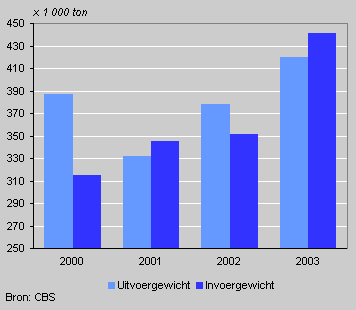More apples from abroad

The yield of apples in the Netherlands fell by 22 percent from 461 million kilograms in 2000 to 359 million kilograms in 2003. This reduced yield caused imports of apples to rise by 40 percent.
Area and yield of apples

Smaller area, harvest down
Fewer apple trees are the main cause of the reduced yield.
The area of apple trees was reduced by 20 percent in the period 2000-2003.
Apples are mostly grown in the provinces of Gelderland (31 percent), Zeeland (17 percent) and Limburg (14 percent). The percentages refer to 2003 but have not actually changed since 2000.
Elstar and Jonagold
The most common varieties grown in the Netherlands are Elstar and Jonagold. The production of Elstar dropped from 167 million kilograms in 2000 to 133 million kilograms in 2003. The production of Jonagold dropped from 162 million kilograms in 2000 to 133 million in 2003. Less common Dutch varieties are Cox, Golden Delicious and Rode van Boskoop. The area where these three varieties are grown was also reduced.
Imports and exports of apples

Imports exceed exports
In 2003 imports of apples amounted to 441 million kilograms thus exceeding exports by 20 million kilograms, whereas in 2000 imports were substantially lower than exports, 315 and 387 million kilos respectively.
Exports were mainly to the EU countries, 87 percent of the total export value of apples (241 million euro) in 2003. Russia accounted for 7 percent.
Considerable price differences
In 2003 imports of apples were worth 269 million euro, 41 percent came from EU countries, 38 percent from Central and South America, 9 percent from South Africa and 7 percent from New Zealand.
There was a striking difference in the price per kilogram between apples imported from other EU countries (almost 0.45 euro) and apples imported from South America, South Africa and New Zealand (0.83 euro). In the period 2000-2002, import prices from these regions were similar.
Ruud Luijendijk